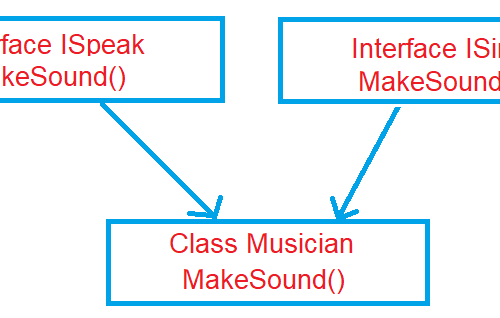Value Type and Reference Type in C# – A Guide to Value vs. Reference Types in C#
When it comes to working with data in C#, understanding the difference between value types and reference types in c# is crucial. These two fundamental data type categories determine how data is stored, manipulated, and passed in your C# programs. In this blog post, we will delve into the concepts of value type and reference type in C#, explore their differences, and provide examples to illustrate their usage.
Table of Contents
Value Type and Reference Type in C#
In C#, data types are broadly categorized into two main categories: value types and reference types. Let’s take a closer look at each of these categories:
Discover a wealth of C# interview questions by visiting our page on C# interview questions: C# Interview Questions.
Value Type in C#
Value types represent data that is stored directly in memory, and each instance of a value type has its own copy of the data. Common examples of value types include integers (int), floating-point numbers (float), characters (char), and structures (structs). When you create a variable of a value type, it directly contains the value, and modifications to one variable do not affect others.
In C#, value types play a crucial role in programming, offering efficient memory usage and improved performance compared to reference types. Value types in c#, including primitive types like integers, floating-point numbers, and characters, as well as user-defined struct types, store their actual data values directly in memory. This direct storage allocation contrasts with reference types, which store references to their data on the managed heap. Understanding the distinctions between value types and reference types is fundamental for C# developers, as it impacts memory management, performance optimization, and overall program design. Leveraging value types appropriately can lead to more efficient and reliable C# applications.
Example 1: Value Type – Integer
int num1 = 42;
int num2 = num1; // num2 gets a copy of num1
num1 = 99; // Changing num1 does not affect num2
Console.WriteLine(num1); // Output: 99
Console.WriteLine(num2); // Output: 42Reference Type in C#
Reference types, on the other hand, store a reference (or memory address) to the actual data. Common reference types include classes, interfaces, delegates, and arrays. When you create a variable of a reference type, it holds a reference to the data, and modifications to one variable can affect others that reference the same data.
Explore the SOLID principles in C# for building robust and maintainable software architectures.
Example 2: Reference Type – Class
class Person
{
public string Name { get; set; }
}
Person person1 = new Person { Name = "Futuretechhub" };
Person person2 = person1; // Both reference the same object
person1.Name = "Kratika"; // Changing via person1 affects person2
Console.WriteLine(person1.Name); // Output: Kratika
Console.WriteLine(person2.Name); // Output: Kratika
Nullable Types in C#
In C#, value types cannot represent missing or null values. To address this limitation, C# introduced nullable types. Nullable types allow value types to have a special value, null, in addition to their regular values. You can declare a variable as nullable by adding a ? after its type.
Example 3: Nullable Type
int? nullableInt = null;
if (nullableInt.HasValue)
{
// Do something with nullableInt.Value
}
else
{
// Handle the case where nullableInt is null
}
Nullable Reference Types in C#
C# 8.0 introduced nullable reference types, which enhance code safety by making reference types non-nullable by default and allowing you to opt into nullable references. This helps catch potential null reference exceptions at compile time.
Explore the world of dictionaries in C# programming to efficiently manage and manipulate key-value pairs.
Example 4: Nullable Reference Type
#nullable enable
string? nullableString = null; // Nullable reference type
string regularString = "Hello"; // Non-nullable reference type
// The following line would generate a warning about possible null reference
int length = nullableString.Length;
#nullable disable
Other C# Data Types
In addition to value and reference types, C# offers various data types to handle different kinds of data, including:
- Booleans (
bool): Represents true or false values. Default value isfalse. - Tuples: A tuple is a lightweight data structure that can hold a fixed number of elements with different types. It is often used when you need to return multiple values from a method.
Example 5: Tuple
var personInfo = (Name: "Futuretechhub", Age: 30);
Console.WriteLine(personInfo.Name); // Output: Futuretechhub
Console.WriteLine(personInfo.Age); // Output: 30
DBNull: Represents a nonexistent or missing value in a database field.
Conclusion
Understanding value types and reference types in C# is fundamental to writing efficient and bug-free code. Value types are suitable for simple data with well-defined values, while reference types are used for more complex data structures and classes. Additionally, nullable types and nullable reference types provide options for handling null values, adding a layer of safety to your C# programs.
Incorporating these concepts into your C# development toolbox will enable you to write more robust and reliable code for a wide range of applications.
FAQs
What are value types and reference types in C#?
In C#, value types are data types that store their actual values directly in memory. Each instance of a value type has its own copy of the data. Examples include integers (int), floating-point numbers (float), and structures (structs). Reference types, on the other hand, store a reference (or memory address) to the actual data. Examples of reference types include classes, interfaces, and arrays.
How do value types and reference types differ in terms of memory management?
Value types are stored directly in memory, and each instance has its own copy of the data. Reference types, however, store a reference to the data, and multiple variables can refer to the same data. This can lead to memory efficiency with reference types when multiple variables need to access the same data.
Can value types be assigned null in C#?
By default, value types in C# cannot be assigned null because they represent actual values. However, C# introduces nullable types (e.g., int?) to allow value types to hold a special null value in addition to their regular values.
What are nullable reference types in C#?
Nullable reference types were introduced in C# 8.0 to enhance code safety. With nullable reference types enabled, reference types are considered non-nullable by default. You can opt into nullable references by using ? or annotating types as nullable. This helps catch potential null reference exceptions at compile time.
When should I use value types, and when should I use reference types in C#?
Use value types when you need lightweight, simple data storage with well-defined values. Use reference types for more complex data structures, classes, and when you want multiple variables to reference the same data.
Are there default values for value and reference types in C#?
Yes, in C#, value types have default values. For example, the default value of an int is 0. Reference types have a default value of null. You can also specify default values explicitly when declaring variables.
Can I convert between value types and reference types in C#?
Converting between value types and reference types often requires explicit casting or conversion methods. While some conversions are built-in and straightforward, others may involve more complex operations.
What is value type and reference type in c#
Value Type:
1. Definition: Value types in C# store the actual data directly within their own memory allocation.
2. Storage: Allocated on the stack, which makes access fast and results in automatic deallocation when the variable goes out of scope.
3. Copy Behavior: When a value type variable is assigned to another, a copy of the actual data is made, resulting in two independent variables.
4. Examples: Examples of value types include int, float, char, bool, and all struct types.
Reference Type:
1. Definition: Reference types in C# store a reference to the memory address where the data is held.
2. Storage: Allocated on the heap, with the reference (pointer) stored on the stack.
3. Copy Behavior: Assigning one reference type variable to another copies the reference, so both variables point to the same data in memory.
4. Examples: Examples of reference types include string, arrays, class objects, interface implementations, and delegate instances.




